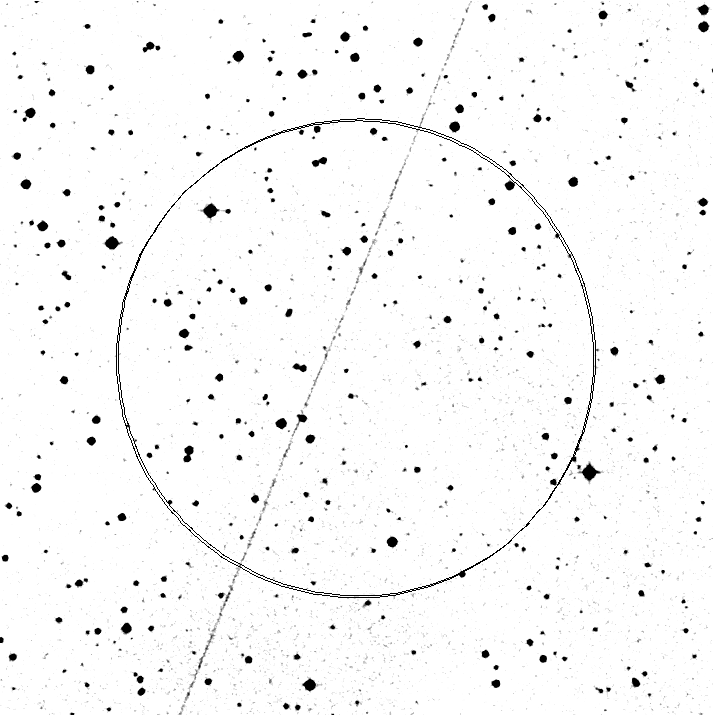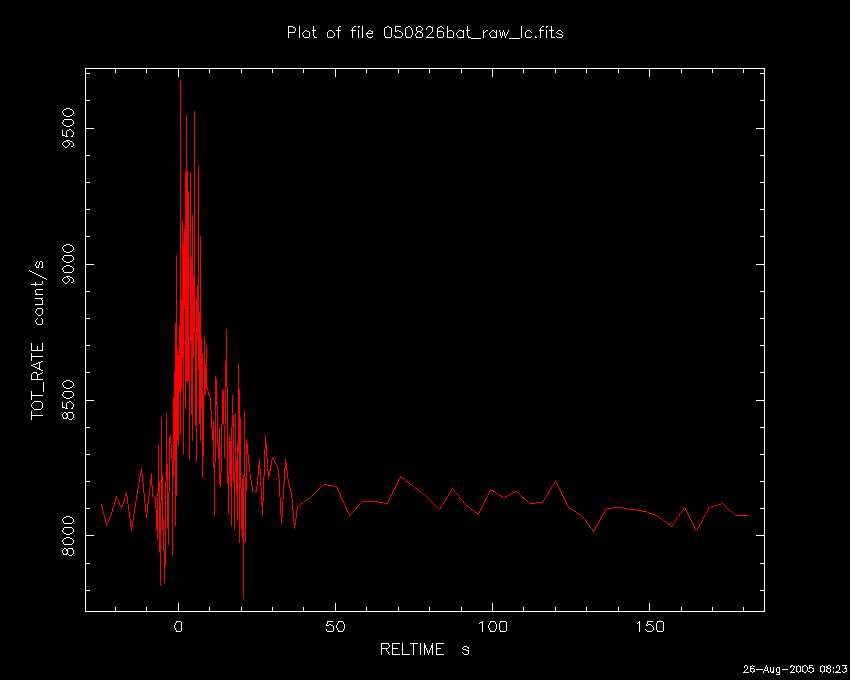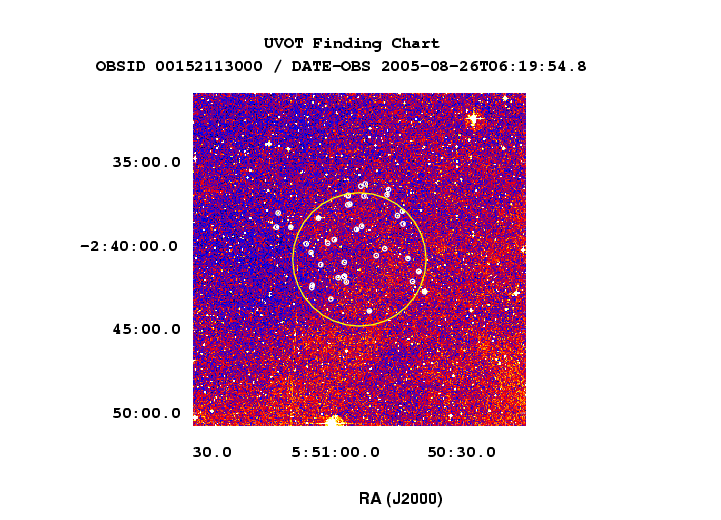(All information courtesy of the instrument teams.)
![]() Previous IAU Circulars
Previous IAU Circulars
TITLE: GCN/SWIFT NOTICE
NOTICE_DATE: Fri 26 Aug 05 06:19:14 UT
NOTICE_TYPE: Swift-BAT GRB Position
TRIGGER_NUM: 152113, Seg_Num: 0
GRB_RA: 87.729d {+05h 50m 55s} (J2000),
87.800d {+05h 51m 12s} (current),
87.101d {+05h 48m 24s} (1950)
GRB_DEC: -2.680d {-02d 40' 46"} (J2000),
-2.679d {-02d 40' 42"} (current),
-2.692d {-02d 41' 31"} (1950)
GRB_ERROR: 4.00 [arcmin radius, statistical only]
GRB_INTEN: 30879 [cnts] Image_Peak=533 [image_cnts]
TRIGGER_DUR: 8.192 [sec]
TRIGGER_INDEX: 490 E_range: 25-100 keV
BKG_INTEN: 221667 [cnts]
BKG_TIME: 22600.00 SOD {06:16:40.00} UT
BKG_DUR: 64 [sec]
GRB_DATE: 13608 TJD; 238 DOY; 05/08/26
GRB_TIME: 22690.28 SOD {06:18:10.28} UT
GRB_PHI: 52.20 [deg]
GRB_THETA: 17.68 [deg]
SOLN_STATUS: 0x3
RATE_SIGNIF: 12.44 [sigma]
IMAGE_SIGNIF: 8.16 [sigma]
MERIT_PARAMS: +1 +0 +0 +4 +2 +3 +0 +0 -36 +1
SUN_POSTN: 155.06d {+10h 20m 14s} +10.36d {+10d 21' 35"}
SUN_DIST: 68.20 [deg]
MOON_POSTN: 55.75d {+03h 43m 00s} +23.39d {+23d 23' 42"}
MOON_DIST: 40.67 [deg]
MOON_ILLUM: 54 [%]
GAL_COORDS: 208.35,-14.68 [deg] galactic lon,lat of the burst (or transient)
ECL_COORDS: 87.47,-26.10 [deg] ecliptic lon,lat of the burst (or transient)
COMMENTS: SWIFT-BAT GRB Coordinates.
COMMENTS: This is a rate trigger.
COMMENTS: A point_source was found.
COMMENTS: This does not match any source in the on-board catalog.
COMMENTS: This does not match any source in the ground catalog.
COMMENTS: This is a GRB.

TITLE: GCN/SWIFT NOTICE
NOTICE_DATE: Fri 26 Aug 05 06:20:07 UT
NOTICE_TYPE: Swift-XRT Nack-Position
TRIGGER_NUM: 152113, Seg_Num: 0
POINT_RA: 87.735d {+05h 50m 56s} (J2000)
POINT_DEC: -2.678d {-02d 40' 39"} (J2000)
GRB_DATE: 13608 TJD; 238 DOY; 05/08/26
GRB_TIME: 22796.53 SOD {06:19:56.53} UT
COUNTS: 201 Min_needed= 20
STD_DEV: 0.00 Max_StdDev_for_Good=28.44 [arcsec]
PH2_ITER: 4 Max_iter_allowed= 4
ERROR_CODE: 2
COMMENTS: SWIFT-XRT Nack Position.
COMMENTS: Algorithm did not converge; too many interations.
TITLE: GCN/SWIFT NOTICE
NOTICE_DATE: Fri 26 Aug 05 06:22:06 UT
NOTICE_TYPE: Swift-BAT GRB Lightcurve
TRIGGER_NUM: 152113, Seg_Num: 0
GRB_RA: 87.729d {+05h 50m 55s} (J2000),
87.800d {+05h 51m 12s} (current),
87.101d {+05h 48m 24s} (1950)
GRB_DEC: -2.680d {-02d 40' 46"} (J2000),
-2.679d {-02d 40' 42"} (current),
-2.692d {-02d 41' 31"} (1950)
GRB_DATE: 13608 TJD; 238 DOY; 05/08/26
GRB_TIME: 22690.28 SOD {06:18:10.28} UT
TRIGGER_INDEX: 490
GRB_PHI: 52.20 [deg]
GRB_THETA: 17.68 [deg]
DELTA_TIME: 65498.00 [sec]
TRIGGER_DUR: 8.192 [sec]
LC_URL: sw00152113000msb.lc
SUN_POSTN: 155.06d {+10h 20m 14s} +10.36d {+10d 21' 35"}
SUN_DIST: 68.20 [deg]
MOON_POSTN: 55.75d {+03h 43m 00s} +23.39d {+23d 23' 42"}
MOON_DIST: 40.67 [deg]
MOON_ILLUM: 54 [%]
GAL_COORDS: 208.35,-14.68 [deg] galactic lon,lat of the pointing direction
ECL_COORDS: 87.47,-26.10 [deg] ecliptic lon,lat of the pointing direction
COMMENTS: SWIFT-BAT GRB Lightcurve.
COMMENTS:
COMMENTS: The next comments were copied from the BAT_POS Notice:
COMMENTS: This is a rate trigger.
COMMENTS: A point_source was found.
COMMENTS: This does not match any source in the on-board catalog.
COMMENTS: This does not match any source in the ground catalog.
COMMENTS: This is a GRB.

TITLE: GCN/SWIFT NOTICE
NOTICE_DATE: Fri 26 Aug 05 06:22:50 UT
NOTICE_TYPE: Swift-UVOT Source List
TRIGGER_NUM: 152113, Seg_Num: 0
POINT_RA: 87.735d {+05h 50m 56s} (J2000)
POINT_DEC: -2.678d {-02d 40' 39"} (J2000)
POINT_ROLL: 77.751d
GRB_DATE: 13608 TJD; 238 DOY; 05/08/26
GRB_TIME: 22795.09 SOD {06:19:55.09} UT
FILTER: 3, V
BKG_MEAN: 1061570777
N_STARS: 1435
X_OFFSET: 1514 [pixels]
Y_OFFSET: 40 [pixels]
X_MAX: 476 [pixels]
Y_MAX: 555 [pixels]
DET_THRESH: 8
PHOTO_THRESH: 3
SL_URL: sw00152113000msufc.fits
SUN_POSTN: 155.06d {+10h 20m 14s} +10.36d {+10d 21' 34"}
SUN_DIST: 68.19 [deg]
MOON_POSTN: 55.77d {+03h 43m 04s} +23.40d {+23d 23' 58"}
MOON_DIST: 40.66 [deg]
MOON_ILLUM: 54 [%]
GAL_COORDS: 208.35,-14.67 [deg] galactic lon,lat of the pointing direction
ECL_COORDS: 87.48,-26.10 [deg] ecliptic lon,lat of the pointing direction
COMMENTS: SWIFT-UVOT Source List.
TITLE: GCN/SWIFT NOTICE
NOTICE_DATE: Fri 26 Aug 05 06:23:28 UT
NOTICE_TYPE: Swift-UVOT Processed Source List
TRIGGER_NUM: 152113, Seg_Num: 0
POINT_RA: 87.735d {+05h 50m 56s} (J2000)
POINT_DEC: -2.678d {-02d 40' 39"} (J2000)
POINT_ROLL: 77.751d
GRB_DATE: 13608 TJD; 238 DOY; 05/08/26
GRB_TIME: 22795.09 SOD {06:19:55.09} UT
FILTER: 3, V
BKG_MEAN: 1061570777
N_STARS: 1435
X_OFFSET: 1514 [pixels]
Y_OFFSET: 40 [pixels]
X_MAX: 476 [pixels]
Y_MAX: 555 [pixels]
DET_THRESH: 8
PHOTO_THRESH: 3
SL_URL: sw00152113000msufc.fits
SUN_POSTN: 155.06d {+10h 20m 14s} +10.36d {+10d 21' 34"}
SUN_DIST: 68.19 [deg]
MOON_POSTN: 55.77d {+03h 43m 04s} +23.40d {+23d 23' 58"}
MOON_DIST: 40.66 [deg]
MOON_ILLUM: 54 [%]
GAL_COORDS: 208.35,-14.67 [deg] galactic lon,lat of the pointing direction
ECL_COORDS: 87.48,-26.10 [deg] ecliptic lon,lat of the pointing direction
COMMENTS: SWIFT-UVOT Processed Source List.

RA(J2000): 05:51:01.3 Dec(J2000): -02:38:37.8with an uncertainty of 8 arcseconds radius (90% containment). This position is 2.7 arcminutes from the BAT position reported in GCN 3884 (Mangano et al).
V 105-6545 777 19.4 B 251-16450 1857 21.2 U 236-12331 823 19.0 UVW1 223-11570 968 19.7 UVM2 209-10662 968 19.3 UVW2 266-17318 1818 20.3Where T_range is the time range post-trigger over which the summed images were accumulated and Exp is the total exposure time of the summed image. The magnitude upper limits are not corrected for extinction.
---------------------------------------------------
Date(UT) Time(UT) t-t0(hours) R(mag)
---------------------------------------------------
Aug. 26 10:42-11:57 4.40- 5.65 21.0 +/- 0.2
Aug. 27 10:43-11:58 28.42-29.67 21.6 +/- 0.2
---------------------------------------------------
The indicated errors are systematic at this stage of the analysis,
but the difference between the two observations is not affected by
systematics. Improvements in precision of position and magnitudes
will be forthcoming from these data. These preliminary magnitudes
should not be used in formal analyses.
---------------------------------------------------
R.A. (2000) Dec. (2000) +/- (")
---------------------------------------------------
Swift XRT 05 51 01.49 -02 38 38.6 3.4
MDM 1.3m OT 05 51 01.58 -02 38 35.8 0.5
MDM 2.4m host 05 51 01.59 -02 38 36.2 0.5
---------------------------------------------------
Second, image subtraction among observations obtained on three
consecutive nights on the MDM 1.3m reveals a point-like OT on
the first night only, and shows that the light is dominated by
the host galaxy on the second and third nights. The OT is offset
~0.4" to the north of the brightest part of the galaxy.
------------------------------------------------------
MDM 1.3m
------------------------------------------------------
Date(UT) Time(UT) t-t0(hours) Diff OT R(mag)
------------------------------------------------------
Aug. 26 10:42-11:57 4.40- 5.65 22.23 +/- 0.15
Aug. 27 10:43-11:58 28.42-29.67 > 22.8
Aug. 28 11:03-11:57 52.75-53.65
------------------------------------------------------
MDM 2.4m Host R(mag)
------------------------------------------------------
Dec. 25 21.67 +/- 0.05
------------------------------------------------------
Third, using the MDM 2.4m, RETROCAM imager, and SDSS r' filter
on 2005 Dec. 25, a bright core and irregular extension of the
presumed host galaxy are clearly resolved in seeing of 1".
The host magnitude listed above is measured in a 1.8" radius.